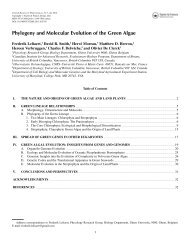Global Ecology and Biogeography - Phycology Research Group ...
Global Ecology and Biogeography - Phycology Research Group ...
Global Ecology and Biogeography - Phycology Research Group ...
You also want an ePaper? Increase the reach of your titles
YUMPU automatically turns print PDFs into web optimized ePapers that Google loves.
H. Verbruggen et al.<br />
Figure 1 Phylogenetic tree of 52 Halimeda<br />
species inferred from six molecular loci using<br />
Bayesian techniques, rooted at the point where<br />
root-to-tip path length variance is minimal.<br />
Numbers at nodes indicate statistical support<br />
(Bayesian posterior probabilities,<br />
in percentages).<br />
dataset. The high scores for the test data indicate adequate model<br />
performance rather than overfitting of the model on the training<br />
data. The predicted distributions are clearly broader than the<br />
known species distributions. For example, the distribution<br />
model of the exclusively Indo-Pacific species H. borneensis<br />
(Fig. 3a) predicts habitat suitability in parts of the Atlantic<br />
Ocean. Similarly, the model of the Caribbean species Halimeda<br />
simulans (Fig. 3b) predicts habitat suitability in parts of the Indo-<br />
Pacific basin. In general, there was a stronger tendency of predicting<br />
Atlantic species into the Indo-Pacific than vice versa.<br />
Niche model at the regional scale<br />
The model predicting suitable habitat for a suite of six Caribbean<br />
species is shown in Fig. 3(c) (AUC ratio = 1.783). Potentially<br />
suitable habitats of these Caribbean species in the eastern Pacific<br />
398 <strong>Global</strong> <strong>Ecology</strong> <strong>and</strong> <strong>Biogeography</strong>, 18, 393–405, © 2009 Blackwell Publishing Ltd

















